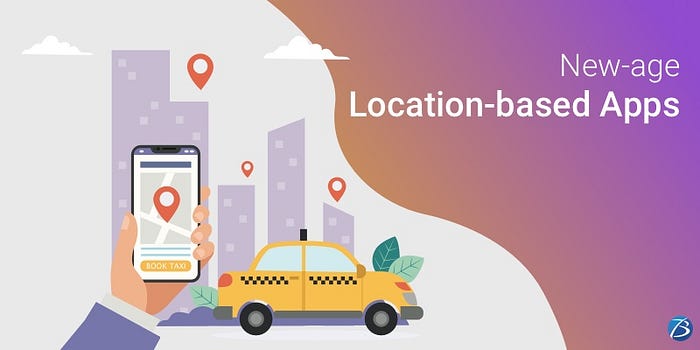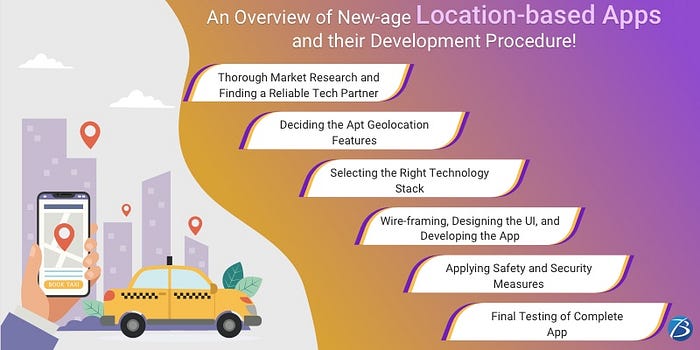5/31/2021
An Overview of New-age Location-based Apps and their Development Procedure!
5/10/2021

Significance of Location-based Applications
Location-Based Services (LBS) are one of the most trending services nowadays. These services are utilized in countless applications like on-demand apps, travel and transportation-related apps, banking apps, social media apps, event planning apps, etc. to name a few. From Instagram to Uber, from Runtastic to Tinder, these apps have impacted millions of peoples’ lives positively. They have eased out several tasks of day-to-day life and made the customer experiences more comfortable.
Here are some top predictions about the location-based services and their applications.
- The LBS market is expected to cross $39.2 Billion by the year 2025, as projected by MarketsandMarkets!
- Another report by Fortune Business Insights forecasts that by 2026, the LBS market size will cross $66.61 Billion.
It is evident from these stunning reports that the LBS and the location-based apps are high in demand. These are being leveraged by several entrepreneurs, start-ups, and business enterprises across the globe at a fast pace.
Top Functions of the Location-Based Tracking Apps
- Communication: Businesses can register their address or any related places on maps. People can add reviews, leave feedback, and also refer to these reviews. Businesses can even link certain content on the map.
- Marketing: Geo-location technologies are used in incentive marketing campaigns for creating interaction mechanics with end-users.
- Information: Customers can get real-time information about the location of a person, place or a bus/train, etc.
Major Types of Location-Based Apps using Geolocation Technologies
On-demand Apps like Uber, Zomato, etc.
Social Networking Apps Facebook, WhatsApp, etc.
Location Tracking Apps like Google Maps, Waze, etc.
Dating Apps like OkCupid, Tinder, etc.
eCommerce Apps like Amazon, eBay, etc.
Travel and Tourism Apps like TripAdvisor, Expedia, Booking, etc.
Health and Fitness Apps like MyFitnessPal, Nike Running Club, etc.
Photo Location Finder Apps like Explorest, Google Photos, etc.
Weather Apps like Weather by Apple, Yahoo Weather, etc.
Some of the examples of the location-based apps developed by us are as below:
- MastR: This is an eCommerce app that enables customers to do virtual shopping. The product categories displayed are based on the location of the product. It also enables scheduled pickups and deliveries.
- BeachCaddy: This app enables end users to request assistance from beach caddies to help them carry beach items. Travel of caddies is tracked through the application.
- Otego: It is restaurant management and a food delivery app. Orders placed by the customers can be tracked on the map.
After looking at these live examples of location-based applications, we are now going to discuss the mobile app development process used for creating apps using geo-location technologies. So let’s commence.
How to Create a New-age Location-based App?

Step 1: Thorough Market Research and Finding a Reliable Tech Partner
You should first decide which type of location-based app you want to build by studying its scope in the market. Market research is mandatory to get the answers to questions like-
- What is my target audience?
- How my app idea will benefit them?
- Who are my competitors?
- What innovation can I offer to my target audience?
- Should I develop an MVP or a full-fledged mobile app?
- How to go about the location-based app development process?
- Which are the top mobile app development companies and whom can I partner with?
Step 2: Deciding the Apt Geolocation Features
It is essential to integrate some core geolocation features and functionalities in your app to make it highly beneficial to the users. These functionalities include Map view, GPS coordinates, user location detection, location history, route mapping, location-based notifications, etc.
Step 3: Selecting the Right Technology Stack
Selecting the right tech stack for geolocation app development is a necessity. Find below the list of a few set of tools required for location-based apps to choose from:
Web:
- HTML5 geolocation API
iOS:
- Google Places API
- Google Maps API
- Google Maps SDK
- Core Location API
- Apple MapKit
Android:
- android.location package
- Google Maps API
- Mapbox
- Google Location Services API
- Google Maps Directions API
- Google Distance Matrix API
- Yandex Maps
- MapView class
- Open Street Map
Step 4: Wire-framing, Designing the UI, and Developing the App
The next step is creating several visual prototypes of the app that match your app idea/concept. After wire-framing, design a user-friendly and responsive app UI. Now begin with the development of a feature-rich location-based application. Pay attention to detail, and get your app developed by an experienced team.
Step 5: Applying Safety and Security Measures
Ensuring data safety is of paramount importance, especially because location-based apps carry sensitive data. So, consider all the existing legal regulations of different countries you are going to target and strictly adhere to their safety regulations.
Follow the below-given practices too for making your app secure:
- Using multi-factor authentication
- Using an SSL certificate
- Encrypting communications
- Using App Transport Security for iOS or Network Security Configuration for Android
- Not storing high-importance data on user devices
- Encrypting sensitive information with algorithms like RSA or AES-256
Step 6: Final Testing of Complete App
The last step is to carry out rigorous testing of the app. Make sure that the app meets all the code requirements. Test-driven development (TDD) is another effective approach. These will help you reduce the potential bugs, and enhance the app quality.
Final Thoughts
Needless to say, location-based apps are enjoying extreme popularity across diverse industries. Owing to their vast benefits, almost every mobile app development company in the market is utilizing this functionality in some of their apps.
So, do you have a great idea for developing a location-based application? Or do you want to enhance your existing app with this amazing functionality? Reach out to the world-class location-based app development company in Texas, USA, for further assistance.
Other articles and publications:
This article sheds light on the rise of location-based apps, their implementation in diverse sectors as well as the business benefits of leveraging LBS.
Learn about the noteworthy use cases and unique ideas for crafting location-based apps and get some handy guidance on implementing them!
10/19/2021
Learn about the features and benefits of virtual event apps and gather detailed insights on event app development.
5/22/2023
Event apps are high in demand and have gained popularity in recent years. Furthermore, the Covid-19 pandemic has completely changed the way the events were conducted.
9/28/2021
This post speaks about the revolutionary features and disruptive benefits of new-age e-Learning mobile apps.
3/27/2023
Mobile apps for event planning and management are trending these days due to the myriad benefits it offers to event organizers as well as attendees.
11/16/2021
Articles and publications of other companies:
Guess how many apps there are on the leading app stores? Do you have an idea? Well, Google App Store has more than 2.8 million apps and more than 2.1 million are available on the Apple Store.
2/20/2019
Over time, cloud computing technology has revolutionized the way entrepreneurs, and developers view successful app development.
11/28/2018
Building A New App: Connecting the Microchips of New Trends
12/12/2018
Whether you’re growing from one to 100, or hiring 100 new employees, here are 11 essential Workable features to help you scale up your hiring to align with your overall business goals.
7/1/2021
The ever-changing reality of regulations and new advances in technology make it more important than ever before that companies adopt a strategy of agility.
12/26/2018
The Internet of Things (IoT) is a buzzword used throughout the tech industry, describing the interconnectedness of hardware products that communicate with each other via the internet.
3/28/2019
Business details
- +1 (469) 277-0804
- 8305 Tripoli Trl, Frisco, TX 75034, United States
- www.biz4solutions.com/
We at Biz4Solutions are based out of Frisco, TX and work with developers working from Pune, India. We mainly focus on building complex custom software solutions for our enterprise customers.











